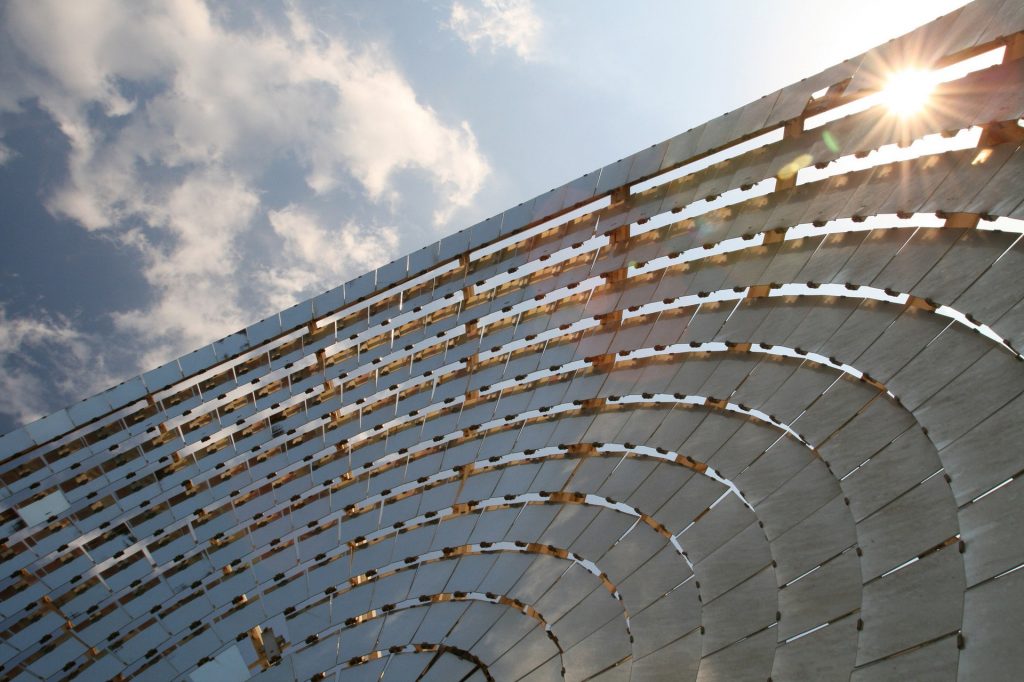Solar Power: More Than Rooftop Panels

Solar Power takes energy from the sun and converts it into electrical or thermal energy to run businesses, homes and heaters. Solar power today is more than rooftop panels. The solar industry is constantly developing technologies that drive down the cost of the equipment and the installation of solar power systems. There is more than one way to draw solar energy to power our world. Photovoltaics, solar heating & cooling, concentration of solar power and passive solar.
Photovoltaic Solar Power
Easily recognized in solar panels on roofs, yards and commercial arrays, photovoltaic solar power collects and converts sunlight into electricity. It can be used to power small electronics, road signs, homes and large commercial businesses. Photons strike the solar panel and ionize semiconductor material on the panel. Electrons are released from the atomic structure. Those electrons are then forced in one direction created by the structure of the crystalline material in the solar panels. Only part of the sun’s rays can be used by a photovoltaic solar panel. Some light is too weak to be absorbed. Other light creates heat energy instead of electricity.
Most photovoltaic solar panels are crystallin silicon, though some thin film panels are used to cut costs. Building-integrated photovoltaics (BIPV) systems are included in the outer layer of buildings or other structures today. These integrations generate electricity for use on-site or for export to the grid. BIPV systems can cut building materials and electricity costs and pollution. Because the buildings and homes with BIPV are designed with them in mind, BIPV can add to their architectural appeal.
Renewable Solar Resources, in Plymouth, Minnesota, installs Photovoltaic solar power systems in homes, businesses and industrial applications. The team at Renewable Solar Resources will meet with you to discuss and review your goals. An onsite energy audit reveal how to maximize your new system if your site meets conditions for a PV system. Whether designing a BIPV or adding an after-market PV system, Renewable Solar Resources can smooth the process to your goals.
Thermal Solar Heating & Cooling
Solar heating and cooling (SHC) systems collect thermal energy from the sun. SHCs use this heat for water heaters, space heating and swimming pool heaters in homes and in commercial applications. Fossil fuels like propane or natural gas were once required to heat and cool. Today, solar heating and cooling systems can do the work, with less pollution or Carbon output. Across the country, American workers are employed manufacturing and installing solar heating and cooling systems. This contributes to diminishing our dependence on imported fossil fuel.
Concentrating Solar Power
In a concentrating solar power (CSP) plant, mirrors are used to concentrate the sun’s energy. This power is then used to drive steam turbines or engines that create electricity. Thermal energy that is concentrated in a CSP plant can be stored in commercial batteries. When the electricity is needed, whether day or night, it is then drawn from storage and used. Roughly 1,815 megawatts of CSP plants are in operation in the United States. Most CSP systems in the United States are used in areas of high concentration of solar radiation, like the Southwest.
Power Tower
A central receiver system allows the power tower system more productivity with higher operating temperatures. Computer controlled mirrors track the sun and focus solar energy on a receiver heating a transfer fluid. The transfer flued produces steam which runs a central power generator.
Parabolic Trough Systems
Curved mirrors are referred to as parabolic trough systems. These mirrors focus the sun’s energy onto a receiver tube in the trough center. A high temperature heat transfer fluid (as high as 750 degrees) runs through the trough, absorbing the sun’s energy. This fluid passes through a heat exchanger to heat water into steam. Steam powers a turbine to generate electricity. There are hundreds of these troughs in a typical collector field, each set to follow the sun east to west.
Linear Fresnel Reflector
Instead of curved mirrors of the parabolic trough, Compact Linear Fresnel Reflectors (CLFR) use flat mirrors to reduce cost. The mirrors, or reflectors, focus sun’s energy onto tubes that heat flowing water within them. The water boils, generating steam for power generation.
Solar has come a long way as a power supply for home and industry. It continues to advance and looks like a great way to protect us against carbon emissions that contribute to our rapid climate change. Now that it has become more efficient and affordable, it’s a great way to contribute to the solution.
